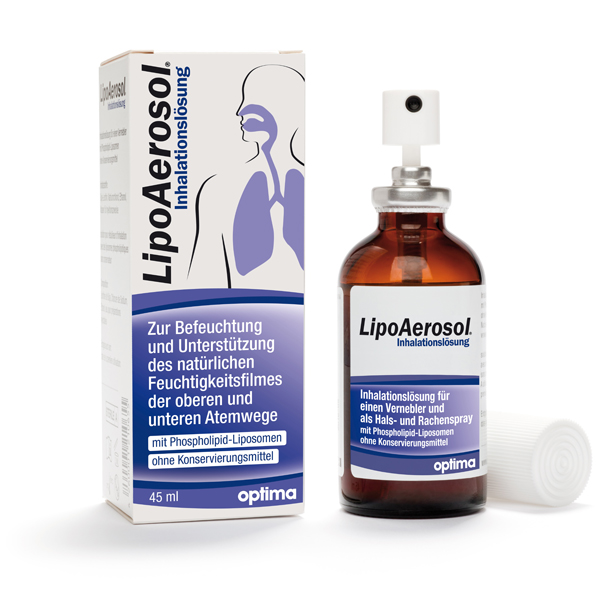LipoAerosol® is used to moisten the upper and lower respiratory tract and to support the natural moisture film in cases of irritation of the mucous membranes and acute or chronic diseases of the respiratory tract.
As a throat spray LipoAerosol® can be used for hoarseness and voice disorders caused by infections of the upper respiratory tract, severe vocal stress, and environmental irritations.
To ensure the best possible tolerability, the product does not contain any preservatives.
TheTopics around LipoAerosol®
Background
Particularly in the case of inflammatory respiratory diseases, there is excessive mucus production, swelling of the mucous membrane and cramping of the respiratory tract muscles, which can also lead to narrowing of the airways.
The mucous membrane of the airways is damaged so that it can no longer fulfil its normal cleaning function (so-called mucociliary clearance). The cough clearance must increasingly take over the cleaning of the airways as a substitute mechanism. An intact moisture film on the mucous membrane is required for the effective operation of the normal self-cleaning system of the airways.

The outer surfactant layer consisting of a mixture of lipids (in particular phospholipids) and proteins is a matter of special importance, because it prevents rupture of the fluid film and drying of mucous membranes.
In addition, the surfactant is extremely important for the cleansing function by improving the interaction of cilia and regulating the flowability of the bronchial secretion. Furthermore, the surfactant also provokes a kind of "lubrication" supporting cough clearance.
Surfactant abnormalities have been reported with respect to in many respiratory diseases (e.g. obstructive pulmonary diseases such as COPD or bronchial asthma, ARDS - Adult respiratory distress syndrome, cystic fibrosis, etc).
In smokers, an impairment of the surfactant can generally be observed: the phospholipid content is reduced compared to non-smokers.
Functions of surfactant:
- biophysical characteristics reducing the surface tension
- maintenance of the fluid balance
- improvement of the cleansing function
- primary immune barrier
Further information:
Huhn C. The inhalative substitution of phosphatidylcholine. New routes in surfactant disorders of the respiratory system. Atemwegs- und Lungenkrankheiten, 2012; 38: 1-9.
Treatment with LipoAerosol®
Coughing and excessive mucus in the respiratory tract are the most annoying symptoms for many patients. These distressing symptoms can be treated and alleviated in addition to the drug therapy for the primary disease.
LipoAerosol® for inhalation
LipoAerosol® is based on a physiological saline solution with the addition of phospholipid-liposomes and can be used with all conventional nebulisers (e.g. PARI).
By inhaling with the nebuliser, larger amounts of fluid can be brought into the bronchial system to treat mucus retention. The supplied moisture liquefies the tough mucus and makes it easier to cough it out.
The ready-to-use solution is simply sprayed directly into the nebuliser and then inhaled. The spray system enables hygienic application and reliably prevents any contamination of the remaining solution.
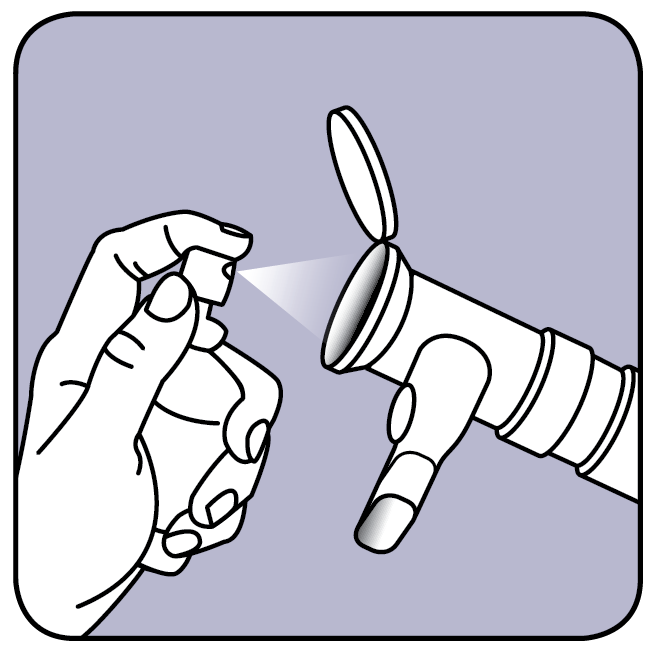
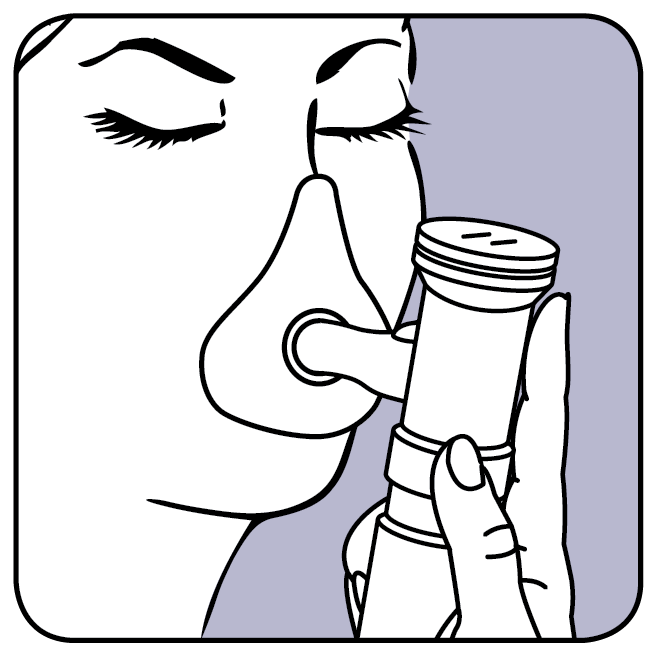
LipoAerosol® is intended for inhalation with a nebuliser. All common ultrasonic, jet (compressed air) or mesh (membrane) nebulisers are suitable for inhalation.
Attention:
The choice of right nebuliser depends on the disease (upper or lower respiratory tract) and on the individual requirements of the user (infant or adult). Different inhalation systems can produce different droplet sizes, which differ in terms of deposition site (i.e. how far the aerosol can penetrate the airways).
Further information: Publication [in German] “Große Wirkung mit kleinen Partikeln“, DAZ 2019, No. 31, p. 40, 01.08.2019
LipoAerosol® as throat spray
Dry and irritated mucous membranes often cause throat irritation such as hoarseness, coughing, frequent throat clearing. In addition, pathogens find favourable conditions on a dry and damaged mucous membrane.
The treatment to relief these symptoms is focused on the lubrication of the mucous membranes in the throat area. Nebulising with the spray system produces an aerosol that is suitable for use in the upper respiratory tract.
Simply spray LipoAerosol® directly into the throat and pharynx several times a day as needed.
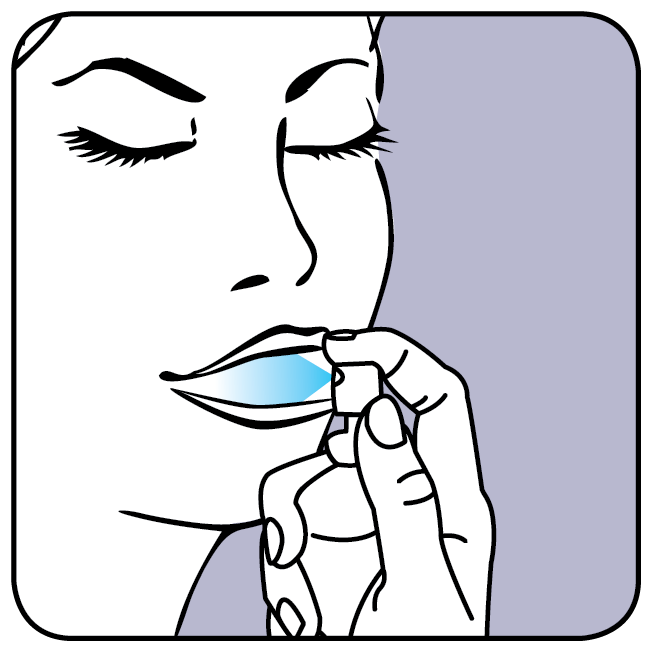
LipoAerosol® can be used up to 6 months after first opening.
Dry, irritating cough
A dry, irritating cough is called non-productive, because it does not bring up any phlegm or mucus.
Coughing fits are often perceived as annoying by those affected and can rob them of restful sleep at night.
The inhalation of LipoAerosol® lubricates the dry mucous membranes and soothes the coughing irritation.
Further information:
Daneshnia R, Wittmann M.
Positive effect of inhalatition therapy with phosphatidylcholine in a case of dry cough caused by drug-induced pulmonary fibrosis.
Atemwegs- und Lungenkrankheiten, 2013; 39: 323-326.

Inflammation of the larynx (Laryngitis)
Laryngitis is an inflammation of the mucous membrane of the larynx. Patients suffer mainly from hoarseness (from a raspy voice to total loss of voice), dry and barking cough, sore throat and breathing difficulties.
Acute laryngitis usually occurs in the context of a viral infection of the upper respiratory tract, often associated with pharyngitis/laryngopharyngitis or inflammation of the trachea (tracheitis).
Chronic laryngitis is caused by environmental influences, especially nicotine or alcohol consumption.
Attention:
If hoarseness persists for longer than three to four weeks, the causes should be clarified by an otorhinolaryngologist as a precaution to exclude a tumour disease (cancer of the larynx).
Inhalation of LipoAerosol® lubricates dry mucous membranes and showed a positive effect in the treatment of laryngitis sicca.
Further information:
Hofauer B, Kirschstein L, Graf S, Strassen U, Johnson F, Zhu Z, Knopf A.
Inhalative Treatment of Laryngitis Sicca in Patients with Sjögren’s Syndrome—A Pilot Study
Clin. Med. 2022, 11, 1081.
Tracheotomy
Tracheostomy is a surgical procedure in which access to the windpipe/trachea (tracheostoma) is created. It is the case of long-term ventilated patients.
Due to the tracheostomy, the normal route through the upper airways is bypassed when breathing in, so that the pre-treatment of the breathing air (such as humidification, warming and cleaning) is inevitably omitted. This leads to the irritation of the lower airways.
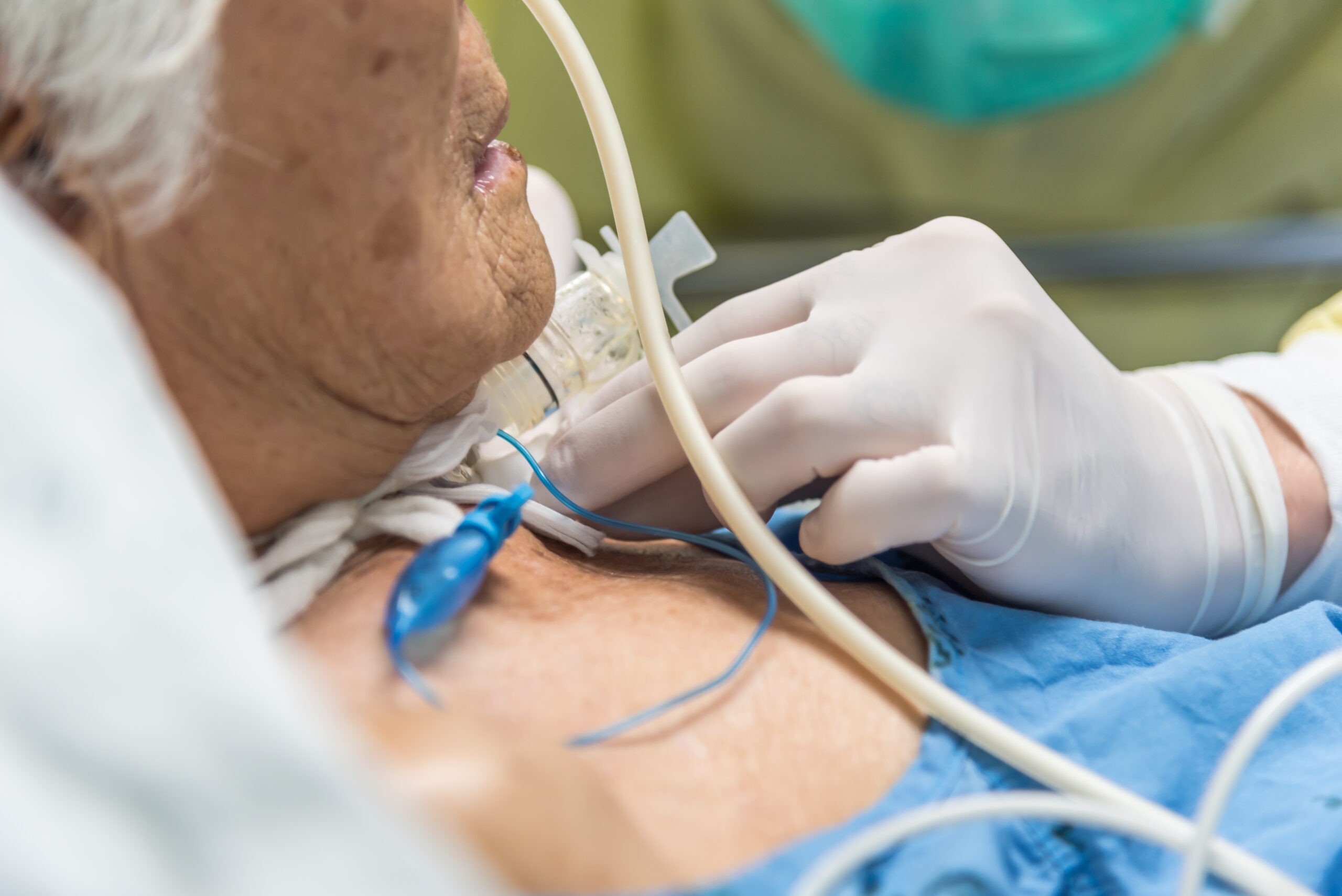
Consequences of the lack of respiratory air conditioning can be:
- increased mucus secretion
- Increased coughing
- drying of the tracheal mucosa
- obstruction of the mucous membrane
- increased infections
- recurrent inflammation of the tracheal mucos
A randomised, double-blinded, placebo-controlled study compared inhalation of LipoAerosol® and conventional physiological saline in 100 patients after tracheostomy.
After LipoAerosol® inhalation, patients shown:
- significant decrease in tracheal IL-6 level (primary endpoint)
- significantly greater improvement in medical examination sum score e.g. frequency of suction manoeuvres, bronchoscopic assessment (secondary endpoint)
- significant reduction in subjective impairment (other endpoint)
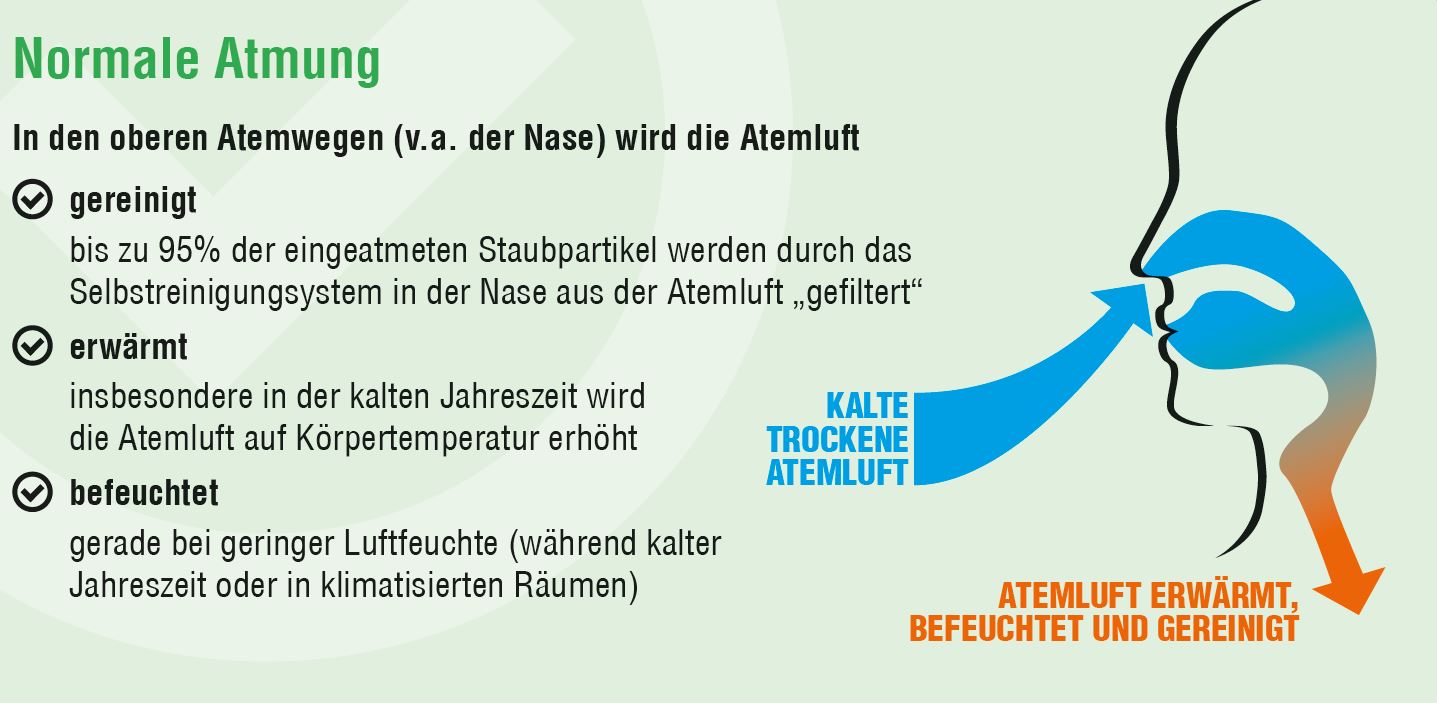
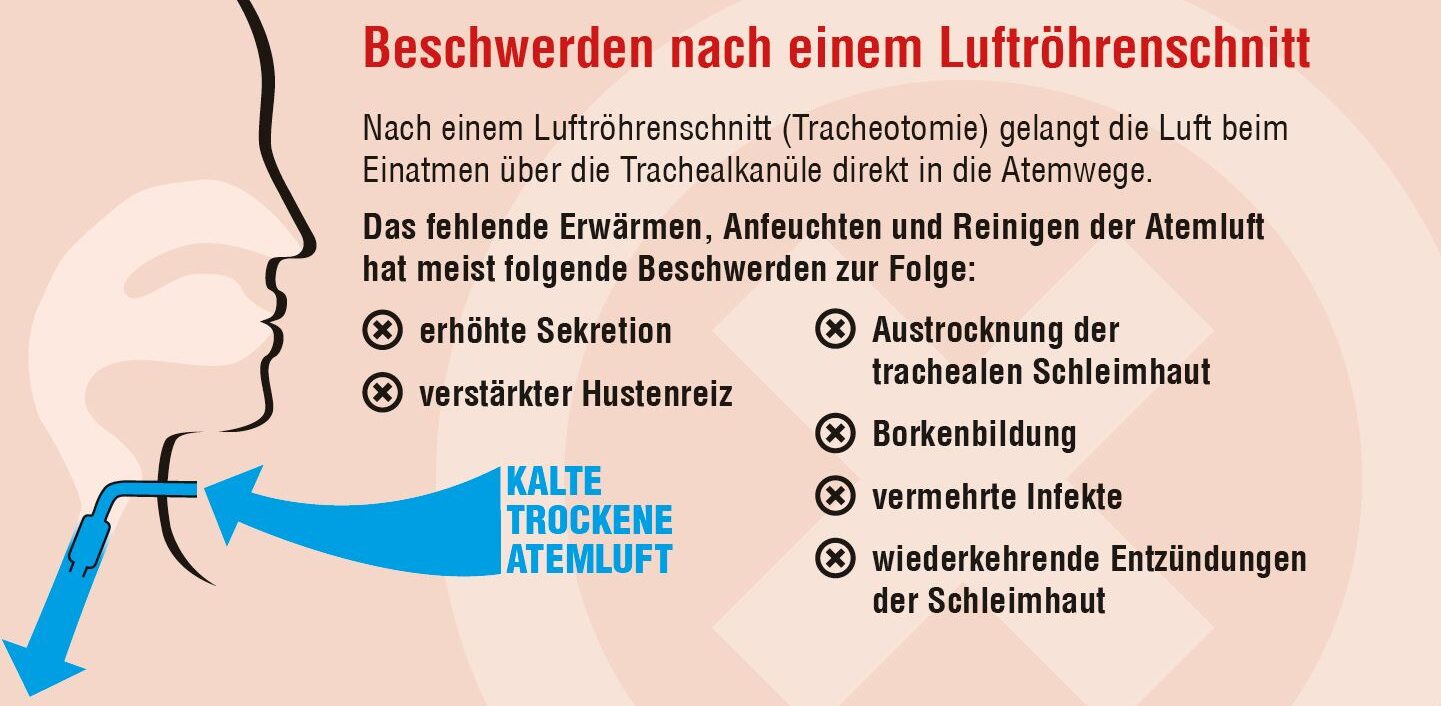
Further information:
Hofauer B, Straßen U, Wirth M, Lenschow M, Bas M, Knopf A.
LipoAerosol-Inhalation for the maintenance of the functional integrity of the tracheobronchial system after tracheostomy
Laryngorhinootologie 2018; 97(S 02): S7
Hofauer B, Straßen U, Chaker A, Schossow B, Wirth M, Wirth M, Bas M, Knopf A.
Liposomal Inhalation after Tracheostomy—A Randomized Controlled Trial.
Clin. Med. 2021, 10, 3312.



